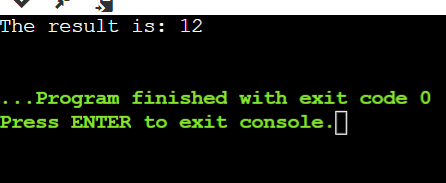'asm' Declaration in C++
A C++ program can contain assembly language code by using the 'asm' declaration. It gives developers fine-grained control over the hardware and software interaction by enabling them to directly insert assembly code into their C++ source code. For performance-critical code segments, where optimizing at the assembly level might result in notable speed gains, the 'asm' declaration is especially helpful.
Although C++ is a very strong and complete programming language, it cannot handle a few extremely specific scenarios. In certain cases, C++ offers the ability to drop an assembly code whenever desired. The 'asm' statement is used in this scenario. The assembly language can be immediately incorporated into the C++ program using the asm statement. One field, which needs to be a string literal, is required for the asm keyword.
Benefits of using ASM:
There are several benefits of the asm declaration. Some benefits of asm are as follows:
1. Performance Optimization:
- Using the 'asm' declaration is mostly done to maximize performance.
- Writing assembly code can often be more efficient than depending on the compiler's optimizations when you need to fine-tune code for optimal speed or minimum resource consumption.
2. Hardware Access:
- Programming in assembly language enables direct access to hardware resources, which makes it essential for tasks like creating device drivers and interacting with specialized hardware.
3. Portability:
- The 'asm' declaration can aid in maintaining portability, even though assembly language is frequently seen as non-portable because of architecture-specific instructions.
- You can build platform-specific code that integrates neatly with the rest of your program by encapsulating assembly code within C++ functions.
4. Bit-Level Control:
- Programming for embedded systems, encryption, and other specialised domains frequently need for exact control over bit-level operations, which assembly language offers.
5. Interfacing with Legacy Code:
- The 'asm' declaration serves as a bridge between high-level C++ and low-level assembly code for interacting with legacy code or external libraries that demand assembly language instructions.
Syntax of asm:
The manner in which you write the 'asm' declaration varies based on the assembly language and compiler you want to use. The 'asm' declaration in C++ has two main syntaxes: the basic syntax and the extended syntax.
Basic Syntax:
The assembly code is supplied as a string inside the 'asm' statement in the basic syntax. Although there is less control over the operands in the input and output, this syntax is simpler.
Extended Syntax:
With the enhanced syntax, you have more control over register allocation because input and output operands are specified directly. When writing sophisticated assembly code, this format is recommended.
Explanation of syntax:
- output_operands:
- In this section, the variables listed are where the assembly code's output values will be stored.
- With x serving as the variable name, it employs the =x For instance, the notation =r(result) denotes that the output will be stored in the 'result' variable.
- input_operands:
- The values to be entered into the assembly code are listed in this section. It makes use of the rx constraint, in which x is the variable name and r is the register constraint.
- For instance, the notation "r"(a) signifies that the variable 'a' is an input operand.
- Clobbered_registers:
- Any registers that your assembly code changes are specified here. For example, you might include "eax" in this area if your assembly code changed the EAX register.
Constraints and Operands:
- The compiler is guided in producing efficient assembly code by the constraints specified in the 'asm' declaration. Among the most often used limitations are:
'r': Any register with a generic purpose.
'm': It is operand for memory. It might be a memory variable.
'a': Accumulator register, or "a", is commonly utilized in arithmetic operations.
'b': The base register, which is frequently used as a memory pointer to data.
'c': Counter register, or "c", is frequently utilized as a loop counter.
'd': Data register, frequently utilized for manipulating data.
'q': SSE or MMX.
'i': An instantaneous value, like a constant.
'n': This operand should not be used with a register.
- Efficient code production depends on the compiler allocating registers in accordance with these requirements.
Program:
Output:

Explanation:
The offered code's reasoning is to use inline assembly language code to add two integer values, a and b, and then put the result in the result variable. Below is a summary of the reasoning:
1. Initialization of Variable:
- int a = 5, b = 7, result; a, b, and result are the three declared integer variables.
- A is set to 5 and B to 7, with the outcome remaining uninitialized.
2. Linear Assembly for Supplementary:
- asm("add %1, %0": "=r"(result): "r"(a), "0"(b));: The addition inline assembly code is contained in this line.
- "add %1, %0": The assembly instructions for adding two values are specified in this portion.
- "=r"(result): In this section, the output constraint indicates that the addition's result should be kept in the result variable.
- "0" (b), "r" (a): These sections outline the input constraints and state that the operands a and b are input. By allowing b to use the same register as the output operand, the constraint "0"(b) can optimize the code.
3. Addition of Inline Assembly:
- The addition inline assembly code is contained in this line: asm("add %1, %0": "=r"(result): "r"(a), "0"(b));.
- "add %1, %0": This section provides assembly instructions for adding two values. "=r"(result): This section defines the output constraint, stating that the addition's result must be kept in the result variable.
- "r" (a) and "0" (b): These sections outline the input restrictions, stating that operands a and b are employed as inputs. Code optimization is possible because of the restriction "0"(b), which permits b to use the same register as the output operand.
|

 For Videos Join Our Youtube Channel: Join Now
For Videos Join Our Youtube Channel: Join Now









